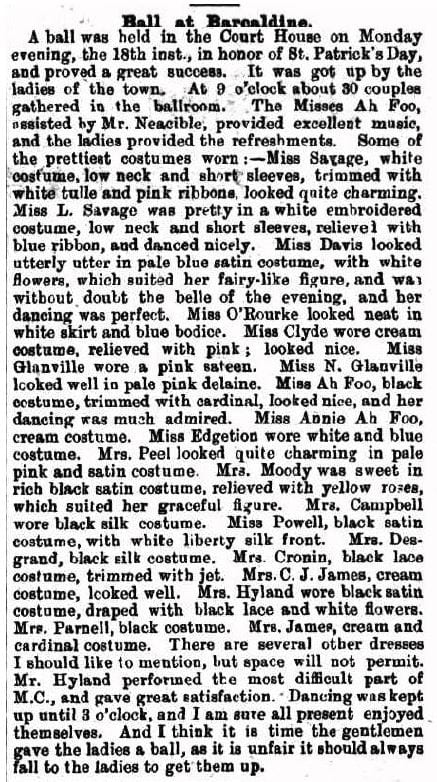Women’s roles, paid and unpaid, were not well documented in the early newspapers, so we have to rely on discovering their public roles and activities through other documents.
One of the first documented pieces of evidence of women’s leadership is available to us in the plaque erected at the Queen Victoria Hospital when it was opened.
In May 1887, Mrs. Francis, wife of the Police Magistrate, called a public meeting of ladies and suggested that Queen Victoria’s jubilee should be celebrated by establishing a hospital to be called the Victoria Cottage Hospital. She told them: ‘As the men have failed in their attempts, it is now the women’s turn’.
When Victoria Hospital was opened in the first week of March 1888, the ladies handed over administration to a committee of men.
THE UNDERMENTIONED LADIES WHO, IN THE JUBILEE YEAR OF QUEEN VICTORIA’S REIGN IN THE SPIRIT OF SYMPATHY AND HUMAN SUFFERING WHICH IS THE GLORY OF THEIR SEX, FIRST THOUGHT OF ESTABLISHING THIS INSTITUTION, AND IN THE FACE OF OBSTACLES WHICH WOULD HAVE DETERRED ALL BUT THE MOST RESOLUTE, CARRIED ON THEIR OWN UNAIDED EFFORTS, THE PROJECT TO A SPEEDY AND SUCCESSFUL ISSUE.
THIS HUMBLE TRIBUTE IS GRATEFULLY AND RESPECTFULLY INSERTED BY THE HOSPITAL COMMITTEE.
MRS. A. M. FRANCIS
MRS W. H. CAMPBELL MRS A. J. A. MOODY MRS J. HYLAND MRS W. H. CAMPBELL MRS A. PARNELL MRS E. A. PEEL MRS. R. MATTHEWS MRS E. C. SHAW MRS R. SUMMER MISS FRANCIS MISS SAVAGE
Not always about their brains

In the 1920s, women cut their hair, shortened their skirts and went out unchaperoned. With the formation of the Queensland Country Women’s Association Barcaldine Branch they began to take a new role in public affairs.
In 1925 the town held its first Queen Competition. For several months supporters of four girls raised money in competition with each other. The Catholic Church benefited by £1,641.8.3 after the Shire Chairman, R. F. Lyons crowned the winning Queen – Miss Edna Lennon – on August 19. The other queens were Frances Hickson, Myra Murnane and B. Lyons (who replaced A. Ogden during the period of fund raising).
Women reached towards new freedom in many ways. In 1929 Coles Players toured the Central West with a play called ‘Her Unborn Child’ to promote birth control. It was advertised as ‘a remarkable production unfolding in realistic manner the frailties of human nature as well as the highest and lost ideals in men and women’. Although couched in such ambiguous terms, the airing of so delicate a subject showed new awareness of women’s affairs. By the mid-thirties the district was served by a travelling Baby Clinic sister and the supper room of the Shire Hall was granted for her use.
Women who took leadership roles in the second world war years were Mrs. M. Urquhart, an energetic president of the Barcaldine Branch of the QCWA and Mrs E. Symonds, president of Women’s War Fund that raised £11,405 in the years 1941-45. In March 1945 when rain closed the northern rail route at the Burdekin bridge near Ayr, these women provided refreshments at Barcaldine railway station for over 9,000 troops directed through the west. At all hours for several weeks they organised donations of food, cut sandwiches, and boiled urns, for which they were awarded a Red Cross pennant in appreciation.
Mrs. Symonds’ work was recognised by presentation of a silver trophy. She was proprietor of a leading drapery, and daughter of Patrick Murnane, a pioneer who came to the town in 1887. Widowed in 1928, Mrs Symonds cared for four daughters as she continued the drapery with help from Miss Beatrice Fysh (for nine years) and N. V. Mather, who remained on staff until retirement in 1973. As her daughters grew older, they also helped, and in 1985 the firm of H. Symonds was in the hands of her daughter, Stasia. Stasia died in Barcaldine in 2017.

